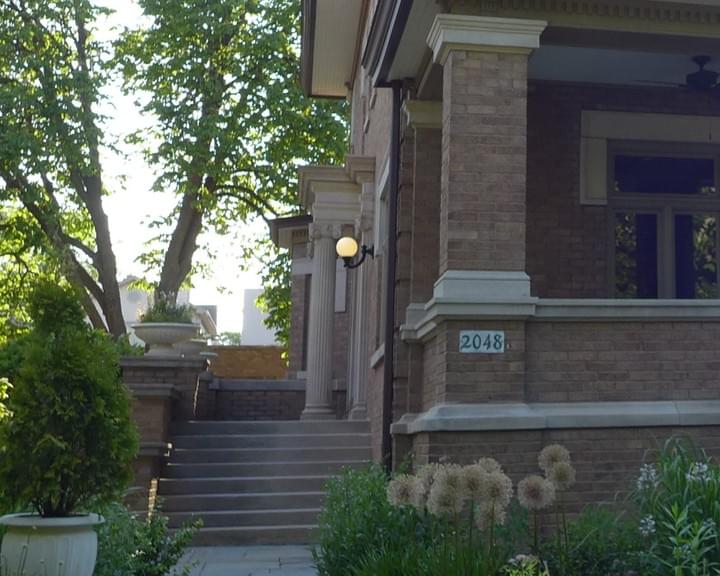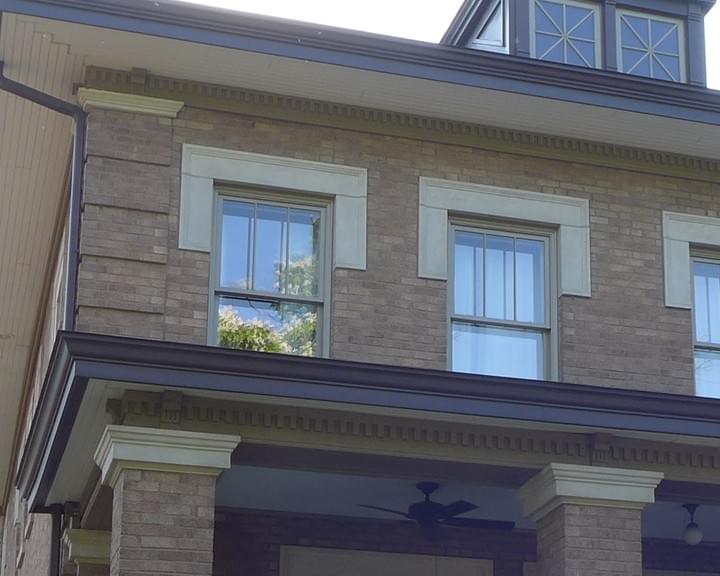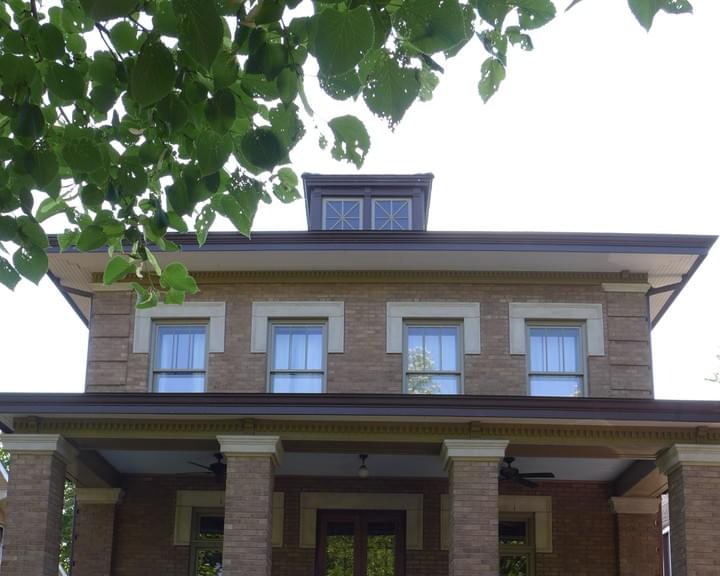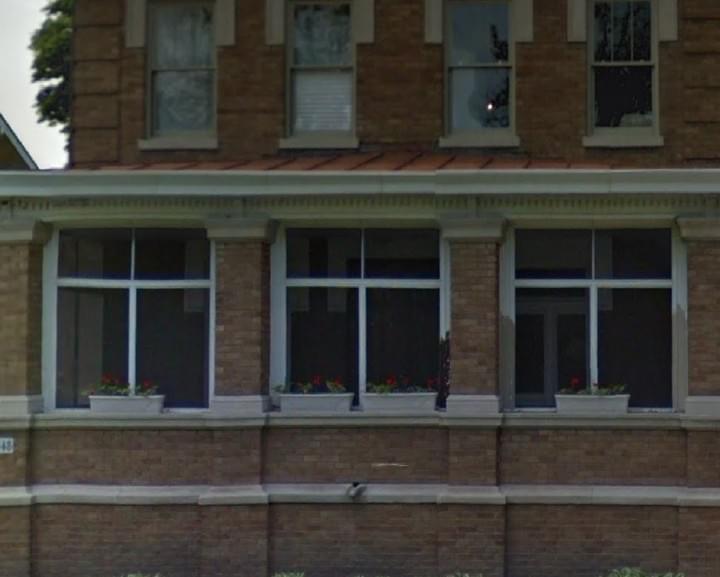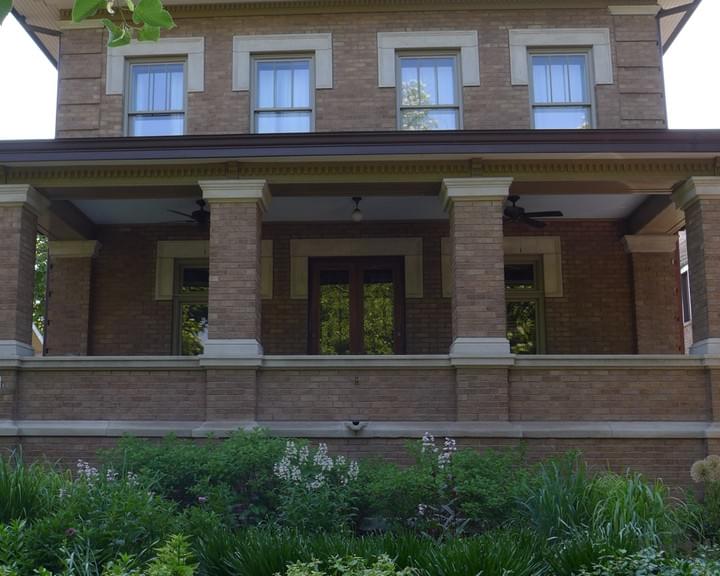
- Welcome / History
- Sites 11-22
- 12. Zuncker House 2312 N Kedzie
- 13. Kreuter House 2302 N Kedzie
- 14. Gainer House 2228 N Kedzie
- 15. Lost Houses of Lyndale
- 16. Beth-El / Boys & Girls Club
- 17. Madson House 3080 Palmer
- 18. Erickson House 3071 Palmer
- 19. Lost Schwinn Mansion
- 20. Corydon House 2048 Humboldt
- 21. Symonds House 2040 Humboldt
- 22.Painted Ladies-1820 Humboldt
- Flipbook & PDF
2048 N. HUMBOLDT Blvd
Year of construction ….............. 1912
Original cost to build .......… $9,000
Architect …........................ Unknown
Original owner … Soren and Herline Corydon
Occupation … Department Store OwnerPrairie Gives Way to Regency
In 1911, Soren T. Corydon, a Danish emigrant, and his family were residing in a cottage on Fairfield Avenue just east of Humboldt Park. The next year they moved just 1.2 miles almost directly north to Humboldt Boulevard in Logan Square. The two-story house was built on the empty lot Soren and his wife, Herline, had just acquired. The architect is not known.
One way to view the house is by comparing and contrasting it with the John Rath House, diagonally across Logan Square to the northeast at 2703 North Logan Boulevard. The Rath House, by architect George Maher, is a pure Prairie School design, while the Corydon House, completed a mere five years later, shows a melding of that style with more traditional residential architecture such as that of the Regency Style.
The similarities are easy to notice. Both houses are rectangular, with living quarters on the first level and sleeping rooms on the second. The main entrance is tucked away on the south side (1). Brick is the prevalent material; the use of stone is limited (2), and decorative ornament is largely absent. They both have covered porches; at the Corydon House, the porch extends out of the main structure. The front façades are symmetrical.
The differences are subtle. The roof of the Corydon House is high enough to allow for dormers, and the overhangs are much smaller (3). Windows are placed in a vertical series, instead of horizontally, giving the house the appearance of greater height. Plain glass, instead of stained glass, is used on the front.
Key Architectural Features:

1. Side entrance

2. Limited stone ornament

3. Regency Style roof

4. Restored front porch - BEFORE

4. Restored front porch - AFTER
In 1915, Corydon had a $600 ($15,000 today) garage built. One of its expensive features was a turntable that allowed automobiles to enter and exit from Humboldt along a side drive and not through the alley.
It’s easy to walk or drive past the house without giving it much notice. It isn’t as unique as its southern neighbor or as decorative as the nearby greystones, and it lacks any distinctive details. But, when studied further, one can recognize the quiet grandeur of the Regency Style.
The unknown architect (perhaps one of the fellow ex-Danes working in Logan Square) should be given credit for designing a residence that is unique on the boulevards. Credit should also be given to the current owners for removing windows that had enclosed the front porch and restoring it to its original, open look (4).
Soren T. Corydon and Family
Soren Thomsen Corydon was a successful businessman in multiple industries, even when compared to the high standards set by the original homeowners along the boulevards. In addition to his mercantile activities, he formed a life insurance company, started a building corporation, was a director of a bank, and served as president of a church board. He led an extremely productive life in the 10 years he lived at 2048 N. Humboldt.
Of Danish ancestry, he was engaged in the dry-goods business in his native country, the German state of Schleswig-Holstein, from 1882 until coming to Chicago in 1889. He married Herline F. Boysen on January 25, 1896. She was born in Chicago in 1875 to Danish-born parents. Even though he left the Danish community in Europe, he would never move far from the Danish-Americans of Chicago.
Herline, the mother of his four children, died at age 41 in March 1916, less than four years after moving into the new house. Later that year, Soren Corydon would take out a permit for the first of several commercial construction projects. He had architect John C. Christensen design a three-story, white terra cotta-faced building at 2704-2710 W. North Avenue that would become Corydon’s Department Store.
On September 18, 1918, Soren Corydon married Mrs. Dagmar R. Anderson (née Thustrup), a native Chicagoan also of Danish heritage. Dagmar had become a widow the previous year, when husband August, another Humboldt Park merchant, died. Her sister, Jennie, was married to John Christensen. The sisters grew up on North Avenue near Talman Avenue.
The 1920s were good for the family, and Corydon’s business ventures thrived. For an unknown reason, in 1922 or 1923, he sold the Humboldt Boulevard home and moved to a rental unit in the Edgewater neighborhood with Dagmar and his two youngest children. He joined the Edgewater Athletic, Edgewater Golf, and Lake Shore Athletic Clubs.
The 1930s was probably a lost decade for Corydon, as the Great Depression did not spare his businesses. The bank closed, but not before he personally added $10,000 to its balance sheet. He and Dagmar were able to retire to a comfortable house in Oak Park, Ill., however. She died in January 1953, three months after her husband.




A Chicago Neighborhood Merchant
Chicago is known for its great merchants: Marshall Field, Montgomery Ward, Richard W. Sears, and so on. But for every enormous State Street department store there were a handful located in its local business districts. These store owners brought needed goods closer to customers and aided in creating the vitality of the neighborhoods. Soren T. Corydon was such a merchant.
Soon after arrival in Chicago, the 20-year-old secured a position as salesman with Edward Ahlswede Dry Goods at the northeast corner of North and Fairfield Avenues, and, in 1894, he was made general manager. Following a brief stint as a buyer for W.A. Wieboldt & Co. in 1898, Corydon partnered with Andrew H. Greenberg the next year to create a new department store.
Greenberg & Corydon was located in the same building that had once housed the Ahlswede store. As it turned out, Corydon would spend the rest of career on this stretch of North, between Western and California Avenues. The business district became known as “The Danish Broadway.”
Corydon purchased his partner’s interest in 1907 (Greenberg returned to real estate) and henceforth conducted the business under his own name. The next year, he expanded the store. Eight years later he built the store building that still stands on North near Washtenaw Avenue. The old store building at the other end of the block became home to the Humboldt State Bank, where he was a director. A two-story brick warehouse was built on Washtenaw around the corner in 1920.
In 1923, he formed the S.T. Corydon Company and became president. Sons Henry and Arthur, and daughters Ella and Lillian, worked there, along with other relatives. The store expanded beyond clothing into groceries and sundries. Corydon offered frequent customers stamps similar to the famous S&H Green Stamps, but he never expanded into other sections of Chicago.
Instead, through the Humboldt Building Corp. he formed with his architect brother-in-law, Corydon bought the large property at the southeast corner of North and California Avenues. Together with John Christensen, he planned to build a business block and theater costing $1 million. When that plan fizzled, they scaled back their ambitions and erected the three-story store and office building that stands there today. Once completed they sold their interest, and Corydon set his sights on the northeast corner.
The closing of Corydon’s Department Store came abruptly as the Danish Tines, November 13, 1935, described ”Last Saturday the Danish Colony was given a big surprise. Mr. Corydon closed his Department store. He laid off all his help, paying them two-weeks salary. All his merchandise was sold to Wieboldt’s. Mr. Corydon, who is 69 years old, withdrew from business life, going on a trip to Florida for the winter to take a long-earned rest.”


Sir Soren T. Corydon
The titans of Logan Square seemed to always be busy. It’s doubtful they were home much. Besides tending to business needs, they created commercial associations and participated in numerous social clubs and fraternal organizations. Wives had their own share of such activities.
Soren Corydon was active in many too many to list, with the most prominent being the Society of Dania and his local church, St. Ansgar’s Danish Lutheran. As with most Chicagoans, especially the foreign-born, he stayed within a community of ex-patriots and his thoughts seldom strayed far from his homeland.
He may not have realized it, but the area across the street from his new house, bounded by Humboldt, Shakespeare, California, and Armitage Avenues, was named “Town of Schleswig” when it was subdivided into lots in the early 1870s. When he was born in February 1868, it had been exactly four years since Danes fought the 10-month Second Schleswig War, which they lost to the Kingdom of Prussia. The results mirrored the First Schleswig War (1848-1852), which was also fought for control of the southern portion of the Jutland Peninsula. Authorities attempted a Germanization policy in the northern part of Schleswig, causing a wave of emigration to North America. Soren and brothers Peter and Anton would be part of that wave.
No doubt the Corydon brothers had close relatives back in Europe. At the onset of World War I, Soren and fellow members of the Society of Dania organized a relief effort on behalf of the people of Schleswig (“Slesvig” in Danish). They shipped clothing and other necessities. For his work, Soren T. Corydon was awarded the Knighthood of Dannebrog by the Danish government in 1925.
House Owners After the Corydons
The second family to live at No. 2048 were the Katzes. Patriarch Henry owned a tannery with his brother, Samuel, who bought the house next door at No. 2050. Their business, Superior Tanning Company, was located at 1254 W. Division Street. The only additional information known about the family is from death records: Daughter Lucille died there in 1926 at 15 years old, Henry died in 1927, and wife Mary died in 1939.
After Mary Katz’s death, the house was sold to Leo Miller, a physician. From the mid-1950s to the 1970s, the house was owned by the Ira Schultz family. It last came up for sale in 2009.
- M.N.P.

Logan Square Preservation
Share your experience of Pillars & Porticos
Copyright © 2020 Logan Square Preservation. All Rights Reserved.

